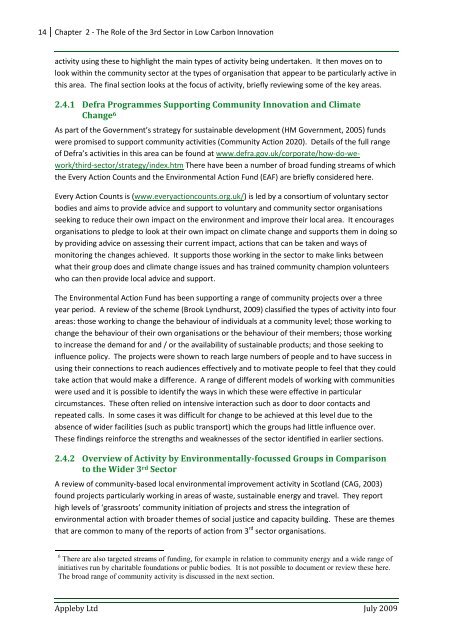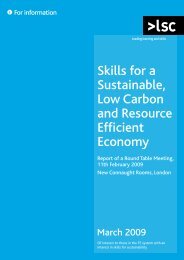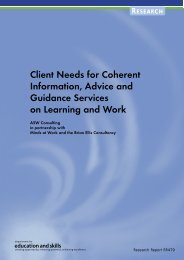Mapping the Big Green Challenge - The Skills & Learning ...
Mapping the Big Green Challenge - The Skills & Learning ...
Mapping the Big Green Challenge - The Skills & Learning ...
You also want an ePaper? Increase the reach of your titles
YUMPU automatically turns print PDFs into web optimized ePapers that Google loves.
14 Chapter 2 - <strong>The</strong> Role of <strong>the</strong> 3rd Sector in Low Carbon Innovationactivity using <strong>the</strong>se to highlight <strong>the</strong> main types of activity being undertaken. It <strong>the</strong>n moves on tolook within <strong>the</strong> community sector at <strong>the</strong> types of organisation that appear to be particularly active inthis area. <strong>The</strong> final section looks at <strong>the</strong> focus of activity, briefly reviewing some of <strong>the</strong> key areas.2.4.1 Defra Programmes Supporting Community Innovation and ClimateChange 6As part of <strong>the</strong> Government’s strategy for sustainable development (HM Government, 2005) fundswere promised to support community activities (Community Action 2020). Details of <strong>the</strong> full rangeof Defra’s activities in this area can be found at www.defra.gov.uk/corporate/how-do-wework/third-sector/strategy/index.htm<strong>The</strong>re have been a number of broad funding streams of which<strong>the</strong> Every Action Counts and <strong>the</strong> Environmental Action Fund (EAF) are briefly considered here.Every Action Counts is (www.everyactioncounts.org.uk/) is led by a consortium of voluntary sectorbodies and aims to provide advice and support to voluntary and community sector organisationsseeking to reduce <strong>the</strong>ir own impact on <strong>the</strong> environment and improve <strong>the</strong>ir local area. It encouragesorganisations to pledge to look at <strong>the</strong>ir own impact on climate change and supports <strong>the</strong>m in doing soby providing advice on assessing <strong>the</strong>ir current impact, actions that can be taken and ways ofmonitoring <strong>the</strong> changes achieved. It supports those working in <strong>the</strong> sector to make links betweenwhat <strong>the</strong>ir group does and climate change issues and has trained community champion volunteerswho can <strong>the</strong>n provide local advice and support.<strong>The</strong> Environmental Action Fund has been supporting a range of community projects over a threeyear period. A review of <strong>the</strong> scheme (Brook Lyndhurst, 2009) classified <strong>the</strong> types of activity into fourareas: those working to change <strong>the</strong> behaviour of individuals at a community level; those working tochange <strong>the</strong> behaviour of <strong>the</strong>ir own organisations or <strong>the</strong> behaviour of <strong>the</strong>ir members; those workingto increase <strong>the</strong> demand for and / or <strong>the</strong> availability of sustainable products; and those seeking toinfluence policy. <strong>The</strong> projects were shown to reach large numbers of people and to have success inusing <strong>the</strong>ir connections to reach audiences effectively and to motivate people to feel that <strong>the</strong>y couldtake action that would make a difference. A range of different models of working with communitieswere used and it is possible to identify <strong>the</strong> ways in which <strong>the</strong>se were effective in particularcircumstances. <strong>The</strong>se often relied on intensive interaction such as door to door contacts andrepeated calls. In some cases it was difficult for change to be achieved at this level due to <strong>the</strong>absence of wider facilities (such as public transport) which <strong>the</strong> groups had little influence over.<strong>The</strong>se findings reinforce <strong>the</strong> strengths and weaknesses of <strong>the</strong> sector identified in earlier sections.2.4.2 Overview of Activity by Environmentally-focussed Groups in Comparisonto <strong>the</strong> Wider 3 rd SectorA review of community-based local environmental improvement activity in Scotland (CAG, 2003)found projects particularly working in areas of waste, sustainable energy and travel. <strong>The</strong>y reporthigh levels of ‘grassroots’ community initiation of projects and stress <strong>the</strong> integration ofenvironmental action with broader <strong>the</strong>mes of social justice and capacity building. <strong>The</strong>se are <strong>the</strong>mesthat are common to many of <strong>the</strong> reports of action from 3 rd sector organisations.6 <strong>The</strong>re are also targeted streams of funding, for example in relation to community energy and a wide range ofinitiatives run by charitable foundations or public bodies. It is not possible to document or review <strong>the</strong>se here.<strong>The</strong> broad range of community activity is discussed in <strong>the</strong> next section.Appleby Ltd July 2009











